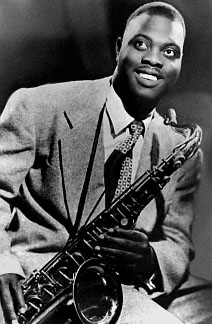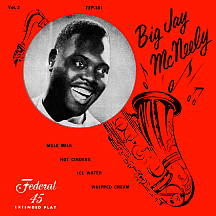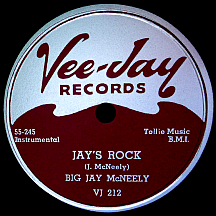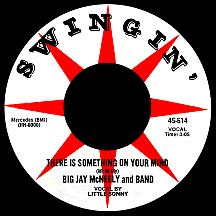BIG JAY McNEELY
There is Something on Your Mind
So, what is the primary instrument of rock and roll? The guitar? Think again. In the beginning, the jazz gods created the saxophone - and the original rockers shook the walls with it. Big Jay McNeely was in on the ground floor of this movement, and starting in the 1940s he and other honkers used it to blow the roof clean off!
The hot sax style can be traced back to drummer and vibes master Lionel Hampton, who utilized saxophonist Illinois Jacquet on his 1943 recording of "Flying Home." The sax solo on that breakthrough hit, though mild by later standards, was unique for its time and aroused many young jazz musicians into trying something new. By the late 1940s several Jacquet-inspired honkers had hit paydirt, including two who scored hits in 1948, "Wild Bill" Moore ("We're Gonna Rock, We're Gonna Roll") and Hal Singer with "Cornbread," the first of the raw, frenzied sax instrumentals to hit number one on the R&B charts.
At the start of 1949, Big Jay hit the scene with "The Deacon's Hop" (issued on Savoy with credit to Big Jay McNeeley's Blue Jays or Deacon McNeeley's Blue Jays, both variations misspelling his name), following Singer by a few months at the top of the R&B charts. The midtempo record rolled out a nonstop progression of honking notes, Jay's tenor sax repeatedly hitting the highs and the lows and the the rasp and the screech, stepping up the intensity of his playing with each bar for nearly three heavenly minutes.
The Barrelhouse Club was a nightspot in the Watts district of Los Angeles, operated circa 1948 by Johnny Otis, who would shortly thereafter become a multidimensional musician/producer/songwriter with many hit records of his own on the Savoy label. The club was located very close to the home of Cecil McNeely, who with his older brother Robert McNeely, hooked up with Otis to record for Savoy. The record label's founder and owner, Herman Lubinsky, didn't see much potential for a guy named Cecil and suggested changing it to Big Jay, which stuck. The sax man's larger-than-life image was simply unavoidable.
The follow-up hit was "Wild Wig," another hot instrumental (that had actually been released before "Deacon's Hop"), after which the hits abruptly stopped. Big Jay took control and shaped his own legend in the forthcoming years through live performances. Picture this: It's the early-'50s, you're in a club, the lights go low...suddenly you're set upon by strobe lights (though you don't yet know they're called that), accentuating a saxophone that appears out of the darkness, clutched by a mountain of man in a lime-green suit who commences to blow the glowing object with abandon, first on his kness, then arching back with the sax high in the air, then on his back as he rolls on the floor, never missing a beat - in fact, hitting many notes in machine-gun-succession, progressively higher and louder until the walls seem to crack! This barrage of blow-your-hair-back madness seems to go for hours, until suddenly the sax-blasting-maniac is up on his feet and heading for the door until he's completely outside the club, still blowing and bouncing the sound off buildings.
Exaggerated legend? Possibly just a little, but Big Jay might take issue with that outlook, and since he's still performing he can attempt to prove the last paragraph's description if he feels like it - and probably will! It was these kinds of wild acts committed by McNeely and others of his time (including Paul Williams, Freddie Mitchell, Joe Houston, Red Prysock and others) that made the honking saxophone a key component of the burgeoning '50s rock phenomenon, as the instrument and its new application became increasingly showcased on hit records.
Big Jay's association with Savoy had run its course by 1950 and he worked his way through several labels over the course of the decade, including Exclusive, Imperial, Federal, Vee-Jay and others, writing most of his own music and waxing some wondrously wild performances (such as '53's "Nervous Man, Nervous," with the band chanting and clapping while Big Jay blows his brains out). But during this period he excited and excelled mostly in club settings. In the early '50s he added a vocal group to his act, at first calling them Four Dots and a Dash. Some excellent singers emerged from this group, including Marvin Phillips, who teamed up with Jesse Belvin as Jesse and Marvin and afterwards with Emory Perry as Marvin and Johnny. Belvin went on to enjoy solo hits including "Goodnight My Love" in 1956.

Without a record deal around 1958, Jay could be spotted gigging in Seattle nightclubs. Los Angeles radio personality Hunter Hancock of R&B station KGFJ started his own label, Swingin', with fellow disc jockey Roger Davenport. Big Jay and his band, which included brothers Robert and Dillard McNeely on baritone sax and bass, respectively, along with singer Haywood Warner, billed as Little Sonny, recorded an album's worth of tracks in a wide, spacious stereo (an unusual approach at the time) in a basement studio on Admiral Way in Seattle. The first Swingin' single, "There is Something on Your Mind," came from this session. The bluesy ballad, a departure for Jay, was a big pop and R&B hit in the spring of 1959 that stayed on the charts for nearly six months. The driving flip, "...Back...Shack...Track," successfully combined R&B with a jazzy feel (and a hot McNeely sax break) and further demonstrated Little Sonny's impressive vocal range.
The following year, Bobby Marchan (previously with Huey (Piano) Smith and the Clowns) had an even bigger hit with an exaggerated, violent and fascinating singing/spoken word version of "There's Something on Your Mind" (note the slightly different title) that twisted the whole meaning of the song. Still, Big Jay and the boys capitalized on their hit for the next few years, finally winding things down around 1963 or '64. Little Sonny returned to his home in Washington, D.C. Big Jay recorded briefly for Warner Bros. ("Big Jay's Count"), but fell on hard times as his style of jazz fell out of favor with the public. By the early 1970s he was working as a mailman, but after several years a renewed demand for "oldies" acts created fresh opportunities. Jay McNeely returned to performing and hasn't looked back.




